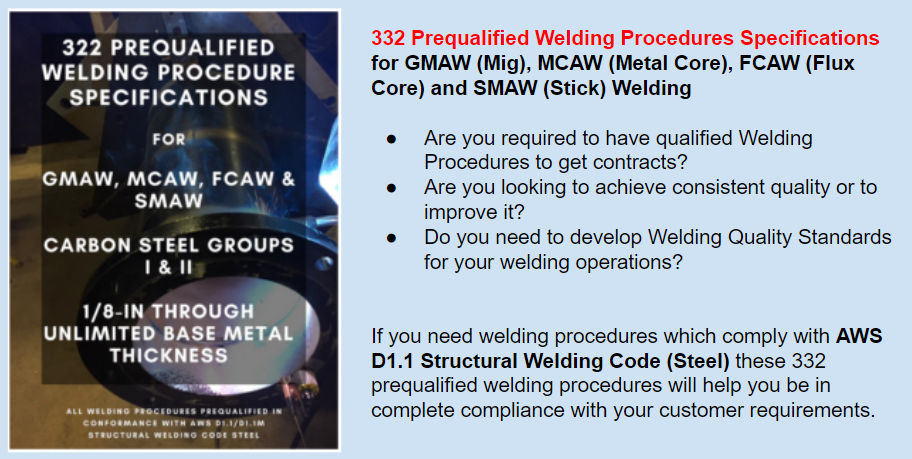Have you ever seen a welding procedure specification with established amperage ranging from 200 to 550 amps? Or voltage ranging from 21 to 29 volts? Or some other variable with a huge window? This is all too common, but extremely dangerous. Why? Because changes to essential variables beyond that which is reasonable will affect the physical and mechanical properties of a weld.
There are three main reasons that contribute to the problem extreme ranges for essential variables, these are:
- There is a need to accommodate all welder skill levels
- Not all welding machine have the same output capabilities and extremely low values must be in place to accommodate the use of light industrial machines.
- Whoever wrote the procedure does not understand how the essential variables can affect important physical and mechanical properties and used the widest range possible based on published data by the filler metal manufacturer.
Amperage and voltage are essential variables we are all very aware of, but there are many more than we need to consider when making changes to a welding procedure specification which has been qualified by testing, or even prequalified.
To understand why this is a problem it is first necessary to understand welding procedure qualification. A welding procedure that requires qualification must undergo a series of tests to determine if it is suitable for producing quality welds. When the test is made the values for essential variables, such as wire feed speed/amperage, voltage, travel speed, shielding gas mixture, shielding gas flow, polarity, etc. are all recorded in the procedure qualification record (PQR). If that procedure passes the tests then the procedure is qualified by testing.
Now, if you take that PQR and write a welding procedure specification (WPS) that uses completely different values for the essential variables, what assurance do you have that the newly written WPS will produce sound welds? Maybe none!
This is why AWS D1.1 and other welding codes specify what changes to essential variables would require a requalification of the welding procedure.
If you have a copy of AWS D1.1:2020 Structural Welding Code – Steel simply turn to Table 6.5 (Table 4.5 in the 2015 edition) and you will see a listing of the changes to PQR essential variables that require WPS requalification. There are some that are intuitive, but there are several that even experienced welding engineers and CWIs may miss. Take a look at the list below and keep it handy any time you think about revising a welding procedure.
This list is for the GMAW welding process. Some of these variables will not apply to other processes such as SMAW, SAW, GTAW and FCAW.
- Increase is filler metal classification strength
- Increase or decrease in filler metal diameter
- Change in number of electrodes (single vs tandem)
- Increasing or decreasing amperage more than 10%
- Changing the type of current (AC to DC or vice versa)
- Changing the polarity (electrode positive to electrode negative and vice versa)
- Changing the mode of transfer
- Increasing or decreasing the voltage by more than 7%
- Increasing or decreasing the travel speed by more than 25%
- Changing the composition of the shielding gas
- Increasing gas flow rate by more than 50% or decreasing it by more than 20%
- Changing to a position that has not been qualified
- Changing to a plate thickness not qualified
- Changing the base metals to one not listed in the PQR
- Change in vertical welding progression (from uphill to downhill or vice versa)
- Changing the type of groove (from square to groove or vice versa)
- Changing (exceeding) the tolerances allowed by code in terms of joint dimensions (for example, groove angle, root opening and root face)
- Omission of backing or backgouging
- Decreasing the preheat temperature by more than 25˚F [15˚C]
- Decreasing the interpass temperature by more than 25˚F [15˚C]
- Adding or deleting of post weld heat treatment (PWHT)
You probably saw items on the list you never considered. Be careful assuming you can use a single WPS to cover a wide range of applications. As expressed above, the reason why all these changes require requalification is because they have the ability to affect the mechanical and physical properties of the weld, base metal and heat affected zone. A simple change to travel speed can affect hat input, weld cooling rates and weld and HAZ microstructure which affects fracture toughness, strength and ductility.
What is discouraging is that you can have a perfectly written welding procedure that is simply not followed in production. To understand why this happens read 11 Reasons Why Welders Don’t Follow Welding Procedures. Spoiler alert: it is usually NOT the welder’s fault. Do you supervise, manage or have any kind of responsibility over welding operations? If so, make sure you understand these reasons.
References: Qualification of Welding Procedures, Welders and Welding Operators per AWS D1.1
AWS D1.1/D1.1M:2015 Structural Welding Code
____________________________________________________________________
Are you looking to qualify welding procedure and/or welders? Are you using AWS D1.1 Structural Welding Code -Steel as your quality standard?
 “Qualifying Welding Procedures, Welders and Welding Operators” is a guide developed to help you perform your own qualifications in full compliance to AWS D1.1 Structural Welding Code. It provides step-by-step instructions on how to qualify welders and welding procedures. It also provide step-by-step instruction on the proper use of prequalified welding procedures.
“Qualifying Welding Procedures, Welders and Welding Operators” is a guide developed to help you perform your own qualifications in full compliance to AWS D1.1 Structural Welding Code. It provides step-by-step instructions on how to qualify welders and welding procedures. It also provide step-by-step instruction on the proper use of prequalified welding procedures.


